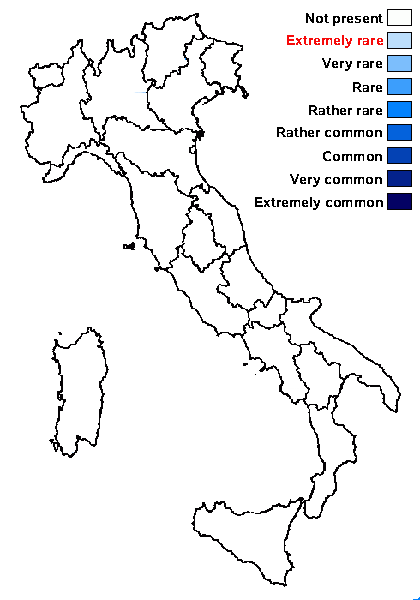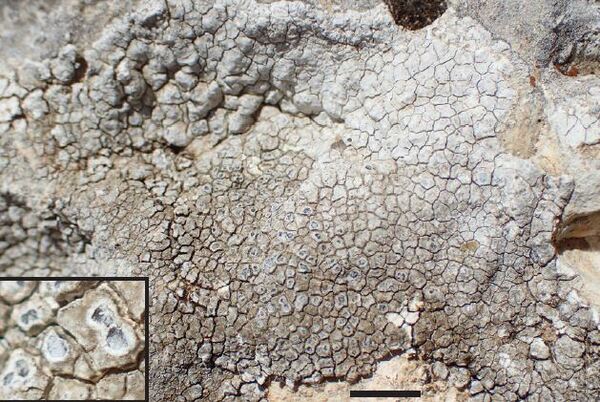Circinaria clercii (Cl. Roux & M. Bertrand)
(provisionally placed here, ICN Art. 36.1b). Basionym: Aspicilia clercii Cl. Roux & M. Bertrand - In Roux & coll., Cat. lichens et champignons lichénicoles de France métropolitaine, 3rd ed.: 1268, 2020.
Synonyms:
Distribution:
Description: Thallus crustose, episubstratic, white, often with a ochraceous, bluish or greenish hue, 0.2-0.7 mm thick, areolate, often delimited by a blackish prothallus, forming orbicular, up to 8 cm wide patches. Areoles angular, smooth, mostly flat, the peripheral ones often longer than wide and radially arranged. Epinecral layer entirely filled by small crystals of calcium oxalates; living part of cortex with a few crystals, its paraplectenchymatous structure therefore well-visible, the upper part greenish brown, the pigment N+ green, K+ brownish yellow (Caesiocinerea-green); algal layer 35-115 µm high; medulla 150-450 µm thick, white, filled by small crystals of calcium oxalates, I-. Apothecia aspicilioid, immersed, 1-2(-5) per areole, mostly round and 0.2-0.8 mm across or slightly elongate and 0.3-0.65 x 0.1-0.35 mm, sometimes confluent, with a concave to flat, black or usually slightly white-pruinose disc, and a white, slightly raised, finally often excluded thalline margin. Proper exciple very thin, colourless; epithecium 13-25 μm high, olive-green to green-brown, inspersed with crystals, N+ emerald green, K+ yellow-brown; hymenium colourless, 140-185 μm high, I+ blue soon turning red-brown; paraphyses septate and anastomosing, submoniliform in upper part, the apical cells 3.5–6.5 μm wide; subhymenium and hypothecium colourless, 50-80 μm high. Asci (3-)4(-6)-spored, clavate to subcylindrical, the thin outer coat K/I+ blue, the wall and apical dome K/I-. Ascospores 1-celled, hyaline, broadly ellipsoid to subglobose, 22-28(-30) x (15-)17-22(-25) µm, often poorly developed. Pycnidia immersed, appearing as black dots. Conidia bacilliform, 6-8(-10) x 0.5-1 μm. Photobiont chlorococcoid. Spot tests: K-, C-, KC-, P-. Chemistry: unidentified lichen substances. Note: a recently-described species, known from France but probably more widespread in upland areas of Southern Europe, growing on more or less calciferous rocks in dry situations. Older records may be hidden under C. calcarea. To be looked for in Italy. For further details see Roux & coll. (2020).
Growth form: Crustose
Substrata: rocks
Photobiont: green algae other than Trentepohlia
Reproductive strategy: mainly sexual

Predictive model
Growth form: Crustose
Substrata: rocks
Photobiont: green algae other than Trentepohlia
Reproductive strategy: mainly sexual

Predictive model


